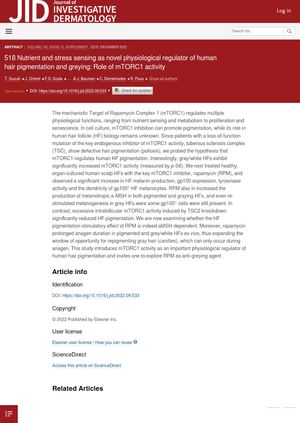Nutrient and Stress Sensing as Novel Physiological Regulator of Human Hair Pigmentation and Greying: Role of mTORC1 Activity
December 2022
in “Journal of Investigative Dermatology”

TLDR Blocking mTORC1 activity could increase hair pigmentation and potentially reverse greying.
The study investigates the role of the mechanistic Target of Rapamycin Complex 1 (mTORC1) in human hair follicle (HF) pigmentation. It was found that grey/white HFs have significantly increased mTORC1 activity. When healthy, organ-cultured human scalp HFs were treated with the mTORC1 inhibitor, rapamycin (RPM), there was a significant increase in HF melanin production, gp100 expression, tyrosinase activity, and the dendricity of gp100+ HF melanocytes. RPM also increased the production of melanotropic a-MSH in both pigmented and graying HFs, and re-stimulated melanogenesis in grey HFs where some gp100+ cells were still present. Conversely, excessive intrafollicular mTORC1 activity induced by TSC2 knockdown significantly reduced HF pigmentation. The study concludes that mTORC1 activity is an important physiological regulator of human hair pigmentation and suggests exploring RPM as an anti-greying agent.
View this study on jidonline.org →
Related

research Functionally distinct melanocyte populations revealed by reconstitution of hair follicles in mice
Only skin melanocytes, not other types, can color hair in mice.